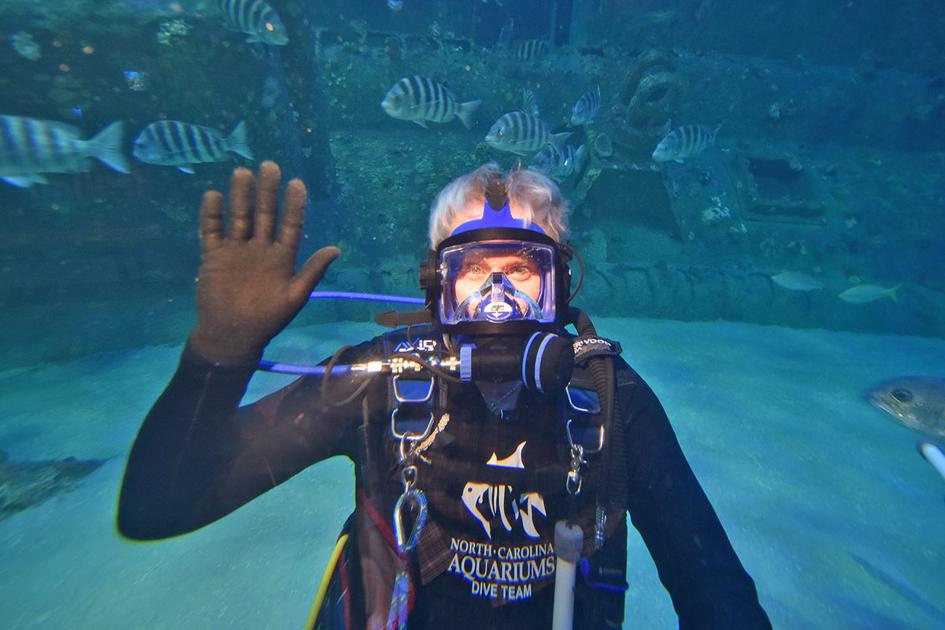Swim behind the scenes of the NC Aquarium at Pine Knoll Shores - Carolinacoastonline
Swim behind the scenes of the NC Aquarium at Pine Knoll Shores - Carolinacoastonline |
| Swim behind the scenes of the NC Aquarium at Pine Knoll Shores - Carolinacoastonline Posted: 25 Jan 2020 09:00 PM PST  High above the Living Shipwreck exhibit, animals that live at the N.C. Aquarium at Pine Knoll Shores anxiously await feeding time. At the sound of the buzzer, chunks of fish, squid and other types of seafood are tossed into the tank and the animals rush into a frenzy as they munch on the day's meal. The site above the Living Shipwreck exhibit is usually off limits to aquarium visitors, but during behind-the-scenes tours, they have a chance to experience how staff provide important care for the creatures. "One thing we are trying to focus on is getting our guests to realize that things are back here for a reason," aquarium special activities coordinator Wayne Justice said. "This is where everything is focused on our staff and our animals' well-being." A major part of the behind-the-scenes tour is learning about the items involved with caring for the animals' needs, including water filtration and the technology involved in keeping the water clean. "The technology that's in place has changed so dramatically over the last 15, 20 years, it's allowed us to kind of push the envelope in some areas and do things very differently in other areas," Mr. Justice said. "We try to highlight some of that work as we go through the tours." One of the first things visitors will see during the tours is the quarantine areas. "Quarantine is a really important part of animal care," Mr. Justice said. "Whether it's in a public aquarium like ours or in a home aquarium, when you get new animals they can be carrying bacteria, parasites, disease and if you place them into an aquarium habitat too quickly, you could infect the entire system, then you would have an empty aquarium and guests would be disappointed, and we would be disappointed." Mr. Justice said the quarantine process consists of 30 days of observation, which may or may not include medical attention. If medical assistance is needed, veterinarians are able to come and care for the animals. The aquarium has a partnership with veterinarians who work at N.C. State Center for Marine Science and Technology in Morehead City. "It's a great partnership because it allows us to have high-quality veterinary care with a great team, but it allows them to work with atypical animals. It's a great network," Mr. Justice said. One of the highlights of the tour is the sea turtles that are brought into the aquarium, whether they are juveniles or cold-stunned adults. The turtles are brought to the aquarium by members of the N.C. Wildlife Resources Commission volunteers and biologists. Those brought to the aquarium are at the facility long enough to receive care before they are released back into the wild. "Our plan is to catch and release. We do not plan to keep sea turtles in our care," Mr. Justice said. However, sometimes turtles are not able to be released into the wild. A prime example is Nimbus, the albino turtle that lives at the aquarium. Mr. Justice said aquarium staff works with the Wildlife Resource Commission to determine if the animals can be released back into the wild. "It's really all about veterinary care," he said. "If the animals are able to survive on their own in the wild, that's our plan and that's our goal. It's important that we have those checks and balances in place that allows us to properly care for them (the turtles), but it also holds us accountable to make sure that healthy animals are finding their way back out in the wild population where they can reproduce and help sea turtle populations to recover from some of the challenges they face." Another way the aquarium staff cares for the animals is through enrichment opportunities. To make the animals feel more comfortable during their stay at the aquarium, aquarists recreate natural habitats, often using PVC pipes. "We are really focused on understanding our animals' needs in the wild and trying to recreate that setting here in the aquarium in a way that's easy for our staff to manage," he said. Another important part of the tour is learning about aquaculture, something Mr. Justice said is possible through advanced technology. The Modular Larval Rearing System, which works with a partnership between the aquarium and aquaculture students at Carteret Community College, allows the aquarium to breed certain fish on site. The same principal applies to jellyfish. Aquarists dedicated to studying the life cycle of the jellyfish have figured out a way to raise them from the beginning stages of life, including determining how much light they receive and the appropriate water temperature. "They are recreating natural processes in an aquarium setting, and that allows us to really be able to raise these animals when we need to, but it took a really thorough understanding of their life cycle," Mr. Justice said. He said the behind-the-scenes-programs allow visitors to see where their money is going. "My main message is when you come and support the aquarium, you are supporting the aquarium," he said. "Your money comes to us and allows us to do a lot of cool stuff back here." Behind-the-scenes tours are offered on a reoccurring schedule. For more information and tour dates, visit ncaquariums.com/pine-knoll-shores. |
| You are subscribed to email updates from "aquarium tank online" - Google News. To stop receiving these emails, you may unsubscribe now. | Email delivery powered by Google |
| Google, 1600 Amphitheatre Parkway, Mountain View, CA 94043, United States | |
Comments
Post a Comment